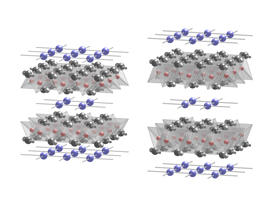

04/27/2020

© 2020 Hideyuki Kawasoko
The temperature at which superconductivity begins in layered, bismuth-containing compounds can be increased by altering the geometry of its crystal structure, an AIMR-led team has discovered1. This could open up a new way to manipulate superconductivity in layered materials and provide vital hints on the mechanism of superconductivity.
Some materials made up of alternating layers are superconductors, the best-known examples being cuprates and iron-based compounds. Although these compounds have been researched intensively, no one knows exactly how they superconduct.
These materials are usually made to superconduct by ‘doping’ them with elements that provide additional electrons. But a recent study has found that twisting a double layer of graphene can induce superconductivity, suggesting that geometric manipulation of crystal structure factors may be important.
Now, Tomoteru Fukumura of the AIMR at Tohoku University and his co-workers have found that compounds consisting of alternating layers of bismuth and of a rare-earth oxide superconduct. Furthermore, they discovered that the temperature for the onset of superconduction increases as the ratio of the distance between the bismuth layers to the distance between adjacent bismuth atoms in a layer increases, or, expressed another way, as the ratio of the lengths of the two sides of the unit cell increases.
The researchers varied this ratio in two ways: they made compounds containing five different rare-earth elements, which have different ionic sizes, and they added excess oxygen atoms to the compounds, effectively wedging the layers apart (see image). Interestingly, the temperature at which superconductivity starts depended only on the structural ratio — it did not depend on which rare-earth element was present or on the magnetic ordering in the rare-earth layer.
“We thought that the compound containing the rare-earth element dysprosium might not be superconducting because it has magnetic ordering, which usually destroys superconductivity,” explains Fukumura. “But even it became superconducting at about 2 kelvin on adding excess oxygen, just like nonmagnetic Y2O2Bi.”
“Layered compounds such as cuprates and iron-based compounds have generally been made to superconduct by carrier doping, but our layered compound becomes superconducting by increasing the unit cell ratio, which is a purely crystallographic parameter,” says Fukumura. “It will be very interesting to see if this parameter induces superconductivity in other layered compounds.”
At this stage, the team is not sure why the ratio affects the superconducting transition temperature. To get more clues, they are investigating where the added oxygen ends up in the crystal structure. They are also looking for a way to vary the unit cell ratio that does not involve adding oxygen to the layered compound.
This research highlight has been approved by the authors of the original article and all information and data contained within has been provided by said authors.